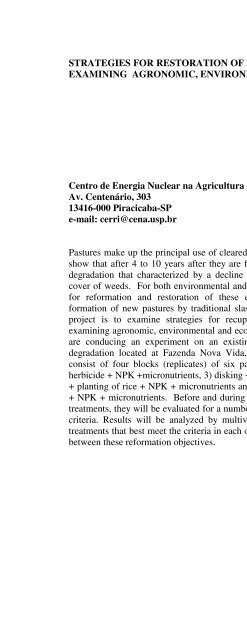A Look at Amazon Basin Seasonal Dynamics with the Biophysical ...
A Look at Amazon Basin Seasonal Dynamics with the Biophysical ... A Look at Amazon Basin Seasonal Dynamics with the Biophysical ...
STRATEGIES FOR RESTORATION OF DEGRADED PASTURES IN AMAZONIAEXAMINING AGRONOMIC, ENVIRONMENTAL AND ECONOMIC CRITERIACarlos Clemente CerriBrigitte Josefine FeiglMarisa de Cássia PiccoloMaria da Conceição Santana CarvalhoJerry Michel MelilloChristopher NeillPaul SteudlerDiana GarciaCentro de Energia Nuclear na Agricultura – CENA/USPAv. Centenário, 30313416-000 Piracicaba-SPe-mail: cerri@cena.usp.brPastures make up the principal use of cleared land in the Brazilian Amazon. Observationsshow that after 4 to 10 years after they are formed, pastures generally begin a process ofdegradation that characterized by a decline in grass productivity and an increase in thecover of weeds. For both environmental and economic reasons, development of strategiesfor reformation and restoration of these existing degraded pastures is preferable toformation of new pastures by traditional slash and burn activities. The objective of thisproject is to examine strategies for recuperation of degraded pastures in Amazôniaexamining agronomic, environmental and economic criteria. To achieve this objective, weare conducing an experiment on an existing 63-ha area of pasture in the process ofdegradation located at Fazenda Nova Vida, in Ariquemes, Rondônia. The experimentconsist of four blocks (replicates) of six pasture reformation techniques: 1) control, 2)herbicide + NPK +micronutrients, 3) disking + NPK + micronutrients, 4) plowing + disking+ planting of rice + NPK + micronutrients and 5) plowing + disking + planting of soybean+ NPK + micronutrients. Before and during the three years following the initiation of thetreatments, they will be evaluated for a number of agronomic, environmental and economiccriteria. Results will be analyzed by multivariate analysis of variance to determine thetreatments that best meet the criteria in each of the three areas and to examine the tradeoffsbetween these reformation objectives.
- Page 570: CONTINENTAL SQUALL LINE FORMATION O
- Page 574: Towards a South American Land Data
- Page 578: SOME CHARACTERISTICS OF THE TURBULE
- Page 582: THE CONVECTIVE SYSTEM AREA EXPANSIO
- Page 586: Horizontal vorticity budget associa
- Page 590: The distribution of convective syst
- Page 594: Relationship between CAPE and Boliv
- Page 598: Wind, Temperature and Moisture Vert
- Page 602: WET-AMC/LBA campaign sounding data
- Page 606: COMPARISON AMONG TWO SIMPLE MODELS
- Page 610: THE NOCTURNAL BOUNDARY LAYER:OBSERV
- Page 614: Explicitly Modeling the Vertical Tr
- Page 618: Productivity, nutrients and sustain
- Page 624: Co-limitation by nitrogen and phosp
- Page 628: Nutrient dynamics through litterfal
- Page 632: Effects of different pasture manage
- Page 636: Phosphorus fractions in earthworm c
- Page 642: Mechanisms of conservation and cycl
- Page 646: Can traditional agroforestry practi
- Page 650: Nitrogen cycling in termite mounds
- Page 654: ALTERATIONS TO NITRATE AND AMONIUM
- Page 658: Organic nutrients in throughfall an
- Page 662: Columbrina glandulosa is stoing hig
- Page 666: Modeling regional soil patterns bas
- Page 670: Wood, soil-macrofauna and nutrients
STRATEGIES FOR RESTORATION OF DEGRADED PASTURES IN AMAZONIAEXAMINING AGRONOMIC, ENVIRONMENTAL AND ECONOMIC CRITERIACarlos Clemente CerriBrigitte Josefine FeiglMarisa de Cássia PiccoloMaria da Conceição Santana CarvalhoJerry Michel MelilloChristopher NeillPaul SteudlerDiana GarciaCentro de Energia Nuclear na Agricultura – CENA/USPAv. Centenário, 30313416-000 Piracicaba-SPe-mail: cerri@cena.usp.brPastures make up <strong>the</strong> principal use of cleared land in <strong>the</strong> Brazilian <strong>Amazon</strong>. Observ<strong>at</strong>ionsshow th<strong>at</strong> after 4 to 10 years after <strong>the</strong>y are formed, pastures generally begin a process ofdegrad<strong>at</strong>ion th<strong>at</strong> characterized by a decline in grass productivity and an increase in <strong>the</strong>cover of weeds. For both environmental and economic reasons, development of str<strong>at</strong>egiesfor reform<strong>at</strong>ion and restor<strong>at</strong>ion of <strong>the</strong>se existing degraded pastures is preferable toform<strong>at</strong>ion of new pastures by traditional slash and burn activities. The objective of thisproject is to examine str<strong>at</strong>egies for recuper<strong>at</strong>ion of degraded pastures in Amazôniaexamining agronomic, environmental and economic criteria. To achieve this objective, weare conducing an experiment on an existing 63-ha area of pasture in <strong>the</strong> process ofdegrad<strong>at</strong>ion loc<strong>at</strong>ed <strong>at</strong> Fazenda Nova Vida, in Ariquemes, Rondônia. The experimentconsist of four blocks (replic<strong>at</strong>es) of six pasture reform<strong>at</strong>ion techniques: 1) control, 2)herbicide + NPK +micronutrients, 3) disking + NPK + micronutrients, 4) plowing + disking+ planting of rice + NPK + micronutrients and 5) plowing + disking + planting of soybean+ NPK + micronutrients. Before and during <strong>the</strong> three years following <strong>the</strong> initi<strong>at</strong>ion of <strong>the</strong>tre<strong>at</strong>ments, <strong>the</strong>y will be evalu<strong>at</strong>ed for a number of agronomic, environmental and economiccriteria. Results will be analyzed by multivari<strong>at</strong>e analysis of variance to determine <strong>the</strong>tre<strong>at</strong>ments th<strong>at</strong> best meet <strong>the</strong> criteria in each of <strong>the</strong> three areas and to examine <strong>the</strong> tradeoffsbetween <strong>the</strong>se reform<strong>at</strong>ion objectives.



